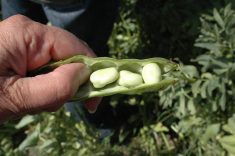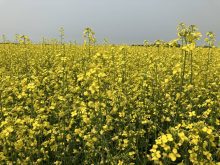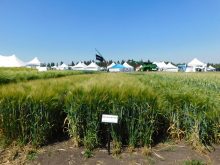“We are capable of handling up to 100,000 acres in Canada this year.”
DAN KUSALIK
GREAT PLAIN S–THE CAMELINA COMPANY
Are you toying with the idea of giving camelina a try, but don’t know what your contract options are, who to contact, or how this crop might suit your diversification needs? There are companies who want to answer those questions… and they offer contracts for you to sign up your acres.
Camelina is being touted as a new wonder crop – a hardy, easy to grow, marketable, and publicly popular as a renewable energy biofuel source. Is it as good as advocates say? Time will tell. If nothing else, it’s worth keeping in mind from a market diversification and a crop back-up plan standpoint, given its positive agronomic attributes.
Read Also

New crop insurer policy enables easier startup for faba beans
Agriculture Financial Services Corporation updated its normals for faba beans, which may open the door for more Canadian producers to feel comfortable growing the pulse crop in the future.
Farmers on the Prairies have only started thinking of camelina as a crop in the last decade. Even though camelina is just in its infancy in terms of crop research, engineering and production, a handful of European and American processors are already competing to sign Canadian producers up for direct-sale contracts.
The major player in this market is Great Plains – The Camelina Company, a biofuel company based in Cincinnati, Ohio. In its fourth year signing Canadian farmers, Great Plains has already achieved around 60,000 acres in Alberta and Saskatchewan and is looking to grow further. “We are capable of handling up to 100,000 acres in Canada this year,” says Dan Kusalik, Great Plains’ vice-president of Canadian operations.
Most producers know there is currently a food versus fuel debate regarding camelina’s best use. Some companies are looking to contract producers to grow for small-scale niche markets, such as salad oil exports to Europe.
“The astute growers always ask the question ‘what’s the market?’”, says Kusalik. Producers have seen niche markets rise and shrink, and might want to prioritize growing for a company that is most likely to offer long-term opportunities. That said, look into all your options in terms of who will offer the best returns, says Kusalik. At this point, the biofuel industrial market looks good. The airline industry “can take as much as we can produce,” says Kusalik.
Great Plains is putting a lot of effort into increasing its number of contracting acres, so it is using every avenue to gain access to producers. “We’re trying to spread the word, we’re talking to everyone we can, be they government ag extension people, ag industry people, or individual producers,” says Kusalik.
He says some producers are nervous about growing a new crop, so Great Plains offers assistance.
“Once producers become contracted growers, we guide them along. We offer a grower guide publication, farm visits from agronomists, trouble-shooting assistance, crop establishment assessments, summer field tours, and as much email and phone support as they want,” Kusalik says. “It’s a big expense, but we believe that it’s important to work with growers very closely to develop this crop.”
Consistent yields
While camelina’s yields and returns are not as high as a good year growing and selling canola, the crop is reported to thrive under dry conditions. Kusalik says that can give growers in the brown soil zone more stable income year-to-year, and, input costs are significantly lower.
Kusalik reports that there has been a sudden surge of interest in central Alberta. Following last year’s drought and spring forecasts, black-soil zone farmers are unexpectedly interested in southern Alberta-type crops.
While most growers will choose ahead of time to diversify into camelina, Kusalik sees potential for some growth to come from last-minute plantings on land that would otherwise be left unintentionally fallow.
“Something like seven to 10 million acres per year are left summerfallow in Canada because of all kinds of challenges from flooding to drought to a high cost of fertilizer,” says Kusalik.
“Camelina is a really viable backup plan. When guys get more familiar with the idea of camelina, they’ll choose to grow it and not have the land left fallow.”
In 2010, the first certified seeds of the Rescue variety, which takes just 80 days to mature, will be available.
Great Plains pays a base initial payment determined on a yearly basis. It then pays a premium based on the published, averaged price of diesel fuel over a three-month delivery and pricing period. Producers choose delivery and pricing periods when they write the contract.














